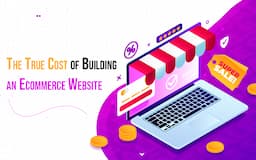Your 10-Step Blueprint to Launching a Successful Online Fashion Store

Starting an online shop selling clothes in 2025 would be a thrilling experience with plenty of opportunities ever since the market has become digitally much friendlier than it used to be. The opportunity in India, especially, is enormous, as the country is huge and its e-commerce market is soaring up. And its citizens are more and more fashion-conscious. Nevertheless, high level of attention should be paid to careful planning and execution in order to succeed on this competitive space.
This comprehensive guide outlines the 10 essential steps to successfully launch and run your own online fashion store. It also highlights how partnering with an eCommerce development company in India can help you achieve your goals. Additionally, you'll discover the strategic support that an India-based online business development company can provide throughout your journey.
1. Come Up with Your Niche and Audience
Prior to thinking of the fabrics and the structure of your website, you must identify your niche. The market in the fashion design business is very full and the attempt to make an appeal to everyone will probably mean that no one is effectively served.
Find Your Love and Function: What type of fashion do you really love? Do you have a liking of sustainable, vintage, active, modest clothing, and maybe street wear (plus size)? You will be passionate and it will drive you.
Gaps/Challenges in Research Markets: Find out areas that are under-catered to by searching on competitors via Google Trends, social media analytics (Instagram, Pinterest, Tik Tok), and social media competitive analytics or accounts. What gaps do the existing brands not have in style, size, price bracket or ethics? E.g. maybe there is a need of stylish and cheap working uniforms among young Indian professionals, or high-standard but socially conductive traditional clothing.
Create Your Dream Customer (Buyer Persona): Get beyond the demographics. Learn about how they live, what they believe in, how they spend their money, what they dress like and where do they hang around on the net. This will be used in making all decisions including the product sourcing and marketing. As a comparison, your target audience can include such segment as: eco-conscious Gen Zers in big cities of India, age 18-25, interested in unique, upcycled clothes and following sustainability activists.
2. Develop a Sound Business Plan
A business plan is your guide, directing your choices and enabling you to obtain funding if necessary. It does not need to be a formal, unyielding document, but it must address essential points:
Executive Summary: A concise description of your business, mission, and vision.
Company Description: What your brand represents, your USP, and how you will remain competitive.
Market Analysis: In-depth study on your target market, industry trends, and competitor analysis (SWOT analysis – Strengths, Weaknesses, Opportunities, Threats).
Product and Sourcing Strategy: Do you create your own garments, employ a print-on-demand (POD) approach, dropship, wholesale pre-made clothes, or a mix?
Dropshipping: Low initial investment, no stock, but reduced control on quality and shipping.
Print-on-Demand: You design your own, third-party handles printing/shipping, ideal for one-off graphics.
Wholesale/Private Label: Purchasing pre-made or white-label products wholesale, relabeling them. Inventory required.
Custom Design/Manufacturing: Greatest control, one-of-a-kind products, but high initial investment and complexity.
Marketing and Sales Strategy: How will you connect with your customers? (More in Step 9).
Operations Plan: How will you handle inventory, orders, shipping, and customer support?
Financial Projections: Initial investments (website, initial stock, marketing, legal), pricing strategy, revenue projections, and profit margins.
Why it matters: Having a well-drafted plan assists you in expecting issues, budgeting resources, and remaining goal-oriented.
3. Manage Legalities and Business Registration
Making sure that your business is legally set up at the beginning avoids hassle down the line.
Select a Business Structure: Sole proprietorship, partnership, Limited Liability Partnership (LLP), or Private Limited Company. All have varying implications on liability and taxation. Ask a legal or financial professional for the best option in India.
Register Your Business: This involves registering with the Ministry of Corporate Affairs (MCA) for companies or local authorities for proprietorships/partnerships.
Obtain Necessary Licenses and Permits: This will vary based on your business structure and location in India. Crucially, apply for a GST (Goods and Services Tax) registration if your annual turnover exceeds the threshold (currently ₹40 lakhs for goods and ₹20 lakhs for services in most states, with some exceptions).
Trademark Your Brand Name and Logo: Safeguard your intellectual property.
Set Up Bank Accounts: Keep business and personal funds separate.
Why this is important: Compliance with the law fosters trust, facilitates smooth operations, and insulates your personal assets.
4. Source Your Products and Manage Inventory
This is where your fashion comes to life.
Supplier Research: Find trusted manufacturers, wholesalers, or dropshipping partners. Search for quality, ethical manufacturing, minimum order quantities (MOQs), price, and lead times. In India, find manufacturers in clusters such as Tiruppur (knits), Ludhiana (woolens), or Surat (textiles, ethnic wear).
Product Development/Selection: If designing in-house, collaborate with designers and manufacturers to develop samples. If buying, select a collection that fits your niche and brand look.
Quality Control: Most importantly, verify the quality of your clothing to your satisfaction. Place sample orders and inspect them carefully.
Inventory Management:
Dropshipping/Print-on-Demand: Since you don't carry inventory, this process is easy.
Holding Inventory: Use an inventory management system (computer or manual) to monitor stock quantities, avoid overselling, and handle reorders. Be prepared to warehouse if you project heavy volumes.
Pricing Strategy: Determine all of the costs (shipping, production, marketing, platform fees) and compare the prices of your competition to ensure competitive prices without sacrificing profit. The goal is healthy profit margins (30-50% is typical in fashion).
Why this matters: High-quality products and effective inventory management are fundamental to customer satisfaction and profitability.
5. Build Your Online Store (E-commerce Platform Selection and Design)
This is the virtual storefront representing your brand.
Select an E-commerce Platform:
Shopify: Easy-to-use, one-stop solution, large app marketplace, suitable for scalability. (Most popular)
WooCommerce (WordPress): Highly configurable, open-source, needs more technical configuration and hosting management.
Magento: Feature-rich, highly scalable, suited best for large companies with complex requirements, needs a lot of development expertise.
Local Indian Platforms: Look at platforms such as Dukaan or StoreHippo if you're targeting mostly the Indian market and require strong regional features.
Website Design and User Experience (UX):
Aesthetically Pleasing: Fashion is a sight. Your website requires a clean, good-looking design that aligns with your brand.
Mobile Optimization: A must for India's mobile-first audience.
Simple Navigation: Simple for customers to navigate categories, filter products, and locate what they're seeking.
Quality Product Images: Professional images and videos (lifestyle images, close-ups, and videos of clothes moving) are a requirement. Think 360-degree views or AR try-on functionalities.
In-depth Product Descriptions: Add fabric, fit, size charts, care labels, and great storytelling.
Effortless Checkout Process: Reduce steps, provide guest checkout, and show shipping charges up-front to avoid cart abandonment.
Payment Gateways: Support popular Indian payment methods such as UPI, Net Banking, major credit/debit cards, and digital wallets (Paytm, PhonePe, Google Pay). Also include Buy Now, Pay Later (BNPL) options.
Get Professional Assistance: This is where an eCommerce website design India company can prove to be extremely helpful. They can:
Offer recommendations on the most suitable platform for your requirements and budget.
Design a custom theme or adapt an existing theme to fit your brand perfectly.
Provide strong security, quick loading times, and mobile responsiveness.
Implement sophisticated features such as AR try-ons, AI personalization, or loyalty programs.
Offer regular maintenance and support.
Why it matters: Your site is your digital flagship store. A beautifully designed, easy-to-use, and secure store establishes trust and converts.
6. Craft Engaging Product Listings
Every product page is a sales page.
Gorgeous Visuals: Multi-angle, high-res images, zoom, and preferably short videos or GIFs. Feature the product on a variety of models.
Detailed and Compelling Descriptions: Go beyond tech specs and describe the garment. What is unique about it? What occasion is it intended for? Identify its point of difference.
Extensive Sizing Guides: This is vital for fashion to minimize returns. Add measurements and concise instructions on how to take measurements. Explore virtual sizing technology.
SEO Optimization: Utilize keywords in product names, descriptions, and alt tags to get your products ranked higher in search results.
Customer Reviews and Ratings: Incorporate a customer review system, establishing social proof and trust.
Why this matters: Excellent product listings educate, convince, and instill confidence and influence conversion rates.
7. Establish Shipping and Fulfillment
Effective logistics are critical to customer satisfaction.
Shipping Strategy: Determine shipping zones (local, national, international), prices (free, flat rate, calculated), and delivery windows.
Logistics Partners: Collaborate with trusted courier companies in India (e.g., Delhivery, Blue Dart, Ecom Express, India Post) with tracking and insurance.
Packaging: Invest in branded, visually appealing, and possibly environmentally friendly packaging that resonates with your values.
Return Policy: Create a straightforward, reasonable, and easy-to-read return and exchange policy. Put it front and center on your website.
Why it matters: Quick, cheap, and dependable shipping is a key motivator of customer loyalty and repeat business.
8. Create a Pre-Launch Marketing Strategy
Generate hype before you open your online doors.
Build an Email List: Design a "coming soon" landing page on your site where people can opt-in to receive updates and special launch promotions.
Social Media Buzz: Begin building anticipation for your brand and products across networks your target audience uses (Instagram, Pinterest, TikTok are primary for fashion). Utilize eye-catching visuals, behind-the-scenes news, and countdowns.
Work with Influencers: Engage micro or nano-influencers whose aesthetic is complementary to your brand and whose audience is engaged.
Teaser Ads: Use targeted ads on social media to create buzz and drive sign-ups.
Why this is important: A solid pre-launch strategy builds hype and guarantees you have a first-day audience ready to purchase.
9. Execute a Post-Launch Marketing & Growth Strategy
Launching is only the start. Ongoing marketing is necessary.
Content Marketing: Develop blog entries, style guides, trend studies, and behind-the-scenes material that establishes your brand as a resource and draws organic traffic.
SEO (Search Engine Optimization): Ongoing optimize your site and product pages for search engines to enhance organic visibility.
Social Media Marketing: Keep your presence active, interact with fans, host contests, and leverage features such as Instagram Shopping and Live Shopping.
Paid Advertising: Use Google Ads, Meta Ads (Facebook/Instagram), and Pinterest Ads to target specific interests and demographics.
Email Marketing: Build your email list with newsletters, new arrivals, promotions, and personalized suggestions.
SMS Marketing: Use SMS for flash sales and immediate updates, very common in India.
Loyalty Programs: Reward repeat customers to promote long-term loyalty.
PR and Partnerships: Pursue media coverage and partner with other complementary brands.
Why it is important: Regular marketing efforts are the key to generating traffic, sales, and a loyal customer base.
10. Focus on Customer Service and Analytics
A high level of excellence in these will lead to sustained success.
Exceptional Customer Service:
Several Channels: Support through email, live chat, WhatsApp (very popular in India), and call.
Quick Response: Opt for fast and informative answers to queries, particularly sizing, returns, and order status.
Personalization: Greet customers by name and remember previous interactions.
Post-Purchase Support: Check in after delivery to validate satisfaction.
Track Key Performance Indicators (KPIs):
Website Traffic: Where are visitors originating?
Conversion Rate: What percentage of visitors purchase?
Average Order Value (AOV): How much customers spend on average?
Customer Lifetime Value (CLTV): Total revenue that a customer is forecasted to bring.
Return Rate: Monitor and inspect motives for returns.
Customer Acquisition Cost (CAC): How much does it cost to acquire a new customer?
Social Media Engagement: Likes, shares, comments. Use tools like Google Analytics and your e-commerce platform's built-in analytics.
Why this matters: Excellent customer service fosters loyalty and positive word-of-mouth. Data analytics provides insights to refine your strategies, optimize operations, and drive continuous growth.
Conclusion
Opening an e-fashion store in 2025, particularly in a changing market like India, is an exciting adventure. By religiously adhering to these 10 steps – ranging from identifying a well-defined niche and establishing a solid business plan to creating a persuasive online presence and emphasizing customer satisfaction – you establish a solid platform for success.
Remember, technology evolves rapidly, so staying adaptable and continuously seeking innovative ways to engage your audience will be key. Partnering with an experienced eCommerce website development company India can provide the technical expertise and market insights needed to transform your fashion vision into a thriving online reality.
Recent Blogs

How Much Does it Cost to Develop a Generative AI App?

Things to Consider Before Hiring a Website Developer
